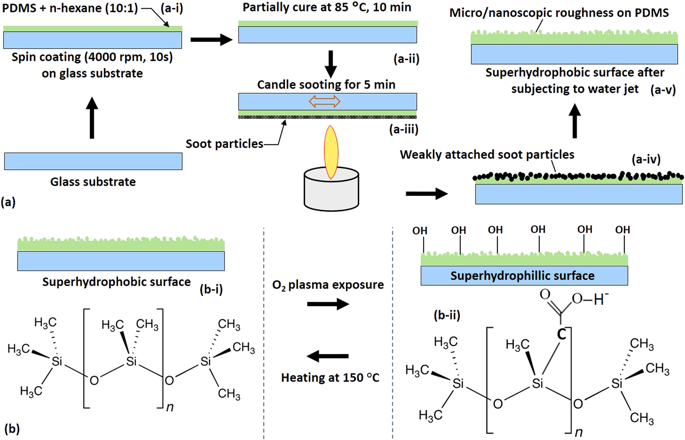Our official English website, www.x-mol.net, welcomes your
feedback! (Note: you will need to create a separate account there.)
Facile fabrication and mechanistic understanding of a transparent reversible superhydrophobic - superhydrophilic surface.
Scientific Reports ( IF 3.8 ) Pub Date : 2018-Dec-21 , DOI: 10.1038/s41598-018-37016-5 B. Majhy , R. Iqbal , A. K. Sen
Scientific Reports ( IF 3.8 ) Pub Date : 2018-Dec-21 , DOI: 10.1038/s41598-018-37016-5 B. Majhy , R. Iqbal , A. K. Sen

|
We report a simple, inexpensive and rapid method for fabrication of a stable and transparent superhydrophobic (TSHB) surface and its reversible transition to a transparent superhydrophilic (TSHL) surface. We provide a mechanistic understanding of the superhydrophobicity and superhydrophilicity and the reversible transition. The proposed TSHB surface was created by candle sooting a partially cured n-hexane + PDMS surface followed by washing with DI water. The nano/microscopic grooved structures created on the surface conforms Cassie - Baxter state and thus gives rise to superhydrophobicity (water contact angle (WCA) = 161° ± 1°). The TSHB surface when subjected to oxygen plasma develops -OH bonds on the surface thus gets transformed into a TSHL surface (WCA < 1°). Both surface chemistry and surface morphology play important roles for the superhydrophobic to superhydrophilic transition. In the Cassie - Baxter relation for a composite surface, due to the capillary spreading of liquid in the nano/micro grooves, both θ1, θ2 = 0, thus giving rise to complete wetting. Rapid recovery of superhydrophobicity from superhydrophilicity was achieved by heating the TSHL surface at 150 °C for 30 min, due to a much faster adsorption of the -OH bonds into the PDMS. Thus it is possible to achieve reversible transition from TSHB to TSHL and vice versa by exposing to oxygen plasma and heat, respectively.
中文翻译:

透明可逆超疏水-超亲水表面的简便制造和机械理解。
我们报告了一种简单,便宜且快速的方法,用于制造稳定且透明的超疏水性(TSHB)表面及其可逆转变为透明的超亲水性(TSHL)表面。我们提供了对超疏水性和超亲水性以及可逆转变的机械理解。提出的TSHB表面是通过将部分固化的正己烷+ PDMS表面用蜡烛吹灰,然后用去离子水洗涤来创建的。在表面上形成的纳米/微观沟槽结构符合Cassie-Baxter状态,因此会产生超疏水性(水接触角(WCA)= 161°±1°)。TSHB表面在经受氧等离子体作用时会在表面上形成-OH键,从而转变为TSHL表面(WCA <1°)。表面化学和表面形态对于超疏水至超亲水转变都起着重要作用。在复合表面的Cassie-Baxter关系中,由于液体在纳米/微沟槽中的毛细管扩散,两个θ1,θ 2 = 0,从而引起完全润湿。通过将TSHL表面在150°C下加热30分钟,可以从超亲水性中快速恢复超疏水性,这是因为-OH键在PDMS中的吸收要快得多。因此,通过分别暴露于氧等离子体和热量下,可以实现从TSHB到TSHL的可逆转变,反之亦然。
更新日期:2018-12-21
中文翻译:

透明可逆超疏水-超亲水表面的简便制造和机械理解。
我们报告了一种简单,便宜且快速的方法,用于制造稳定且透明的超疏水性(TSHB)表面及其可逆转变为透明的超亲水性(TSHL)表面。我们提供了对超疏水性和超亲水性以及可逆转变的机械理解。提出的TSHB表面是通过将部分固化的正己烷+ PDMS表面用蜡烛吹灰,然后用去离子水洗涤来创建的。在表面上形成的纳米/微观沟槽结构符合Cassie-Baxter状态,因此会产生超疏水性(水接触角(WCA)= 161°±1°)。TSHB表面在经受氧等离子体作用时会在表面上形成-OH键,从而转变为TSHL表面(WCA <1°)。表面化学和表面形态对于超疏水至超亲水转变都起着重要作用。在复合表面的Cassie-Baxter关系中,由于液体在纳米/微沟槽中的毛细管扩散,两个θ1,θ 2 = 0,从而引起完全润湿。通过将TSHL表面在150°C下加热30分钟,可以从超亲水性中快速恢复超疏水性,这是因为-OH键在PDMS中的吸收要快得多。因此,通过分别暴露于氧等离子体和热量下,可以实现从TSHB到TSHL的可逆转变,反之亦然。































 京公网安备 11010802027423号
京公网安备 11010802027423号